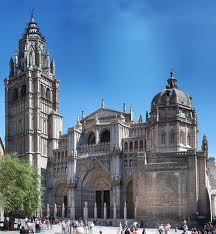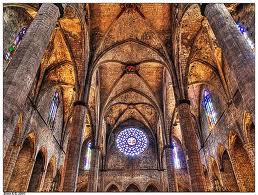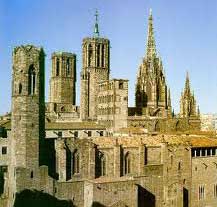Mediterranean Gothic Architecture

Much like Gothic architecture was not a uniform phenomenon throughout the continent, in the relatively restricted environment of the Iberian peninsula it also developed striking differences of style over the years. Thus, while the Castilian Gothic belonging to the cathedrals of Burgos and Leon has a strong French influence, samples of Gothic architecture along the Mediterranean, such as Barcelona Gothic, develop an alternative aesthetic.
One common trait of the Gothic buildings erected along the Spanish Mediterranean coast and islands is their relatively late appearance, all of them being erected towards the turn of the XIV century or through the first fifty years of the 1300s. Thus, pertaining to the most established High Gothic, it would be natural to think that Mediterranean Gothic would be crowded with all the gadgets of the most elaborate architecture of the time.
And yet, if you were looking for a trip to Barcelona and you ended up walking in the Gothic Quarter of the city, you would come across a handful of period buildings, all of which are more sober in style than previous Castilian Gothic constructions, such as the Toledo Cathedral.
Barcelona Gothic

One of the emblematic symbols of Barcelona Gothic style is the church of Santa María del Mar, in La Ribera. Totally massive from the outside, the church displays the sober facade characteristic of the region's Gothic style. Other than the imposing tower, a modest rose window and the main portal with seven jambs and archivolts, the building is purposely austere. Moreover, the weight distribution is managed through traditional buttresses, which reinforce its solid look.
Once inside Santa María del Mar, however, the atmosphere attains all the effectism typical of Gothic architecture: superbly tall rib-vaulted ceilings along the nave, matched on either side by the aisles; impressive luminosity, achieved through numerous windows high up on the structure; and an almost total absence of walls, as everything is held by slender columns, allow light to seep from side to side, creating an impression both of spaciousness and concealment.
Barcelona Gothic is also finely represented in the city's cathedral, although the traditional characteristics of the old style are harder to discover in this building, following neo-Gothic additions to the structure in the XIX century, especially in the ornamentation of the sumptuous facade and the erection of the two flank towers, the spire and the elaborate pinnacles.
Indoors, however, La Seu, as the cathedral is affectionately known among locals, remains a faithful sample of Gothic aesthetic, with open, luminous spaces filled with the colourful atmosphere created by myriad stained glass windows and numerous chapels whirling in and out of the high rib-vaulted aisles and around the altar in a typically northern use of the apse.
Levantine Gothic
The equivalent to the Barcelona Gothic in other regions of Spain is what has come to be termed the Levantine Gothic. The cathedral in Palma de Mallorca, emerging dramatically on the edge of the bay, is considered to be the principal example of this architectural tendency. Built over an ancient mosque, it was first intended to be erected somewhere near the time when the island was taken from Muslim ownership, in 1229, but the actual construction did not begin until 1300.

Like the Barcelona Gothic churches we have looked at, Mallorca Cathedral is a hall church with naves and aisles rising dramatically to the same height. The high ceilings allow for one of the largest rose windows of the time to be installed right at the front of the church, curiously adorned with a six-point star. Unlike most Gothic architecture across the Mediterranean, there is extensive use of flying buttresses at Mallorca Cathedral, carrying the weight of the structure to the outer walls and buttresses.
Levantine Gothic was prevalent as well in Valencia, and not only focused on the construction of religious buildings. As a matter of fact, a major concern among residents of both Barcelona and Valencia was the regeneration of civilian structures and the creation of new private lodgings that evidenced the development and riches attained by the Kingdom of Aragon through its conquests in Italy and Greece, such as the Palacio Real Mayor of Barcelona.
